Sukhothai & Phitsanulok
Bus to Old Sukhothai
We wanted to explore a little more of northern Thailand before leaving for Laos. So we decided to take a bus down south to Sukhothai. We arrived at the Chiang Mai bus station with no advance tickets and found out we would have to wait about 3 hours for the next departing bus. Eventually we boarded the bus scheduled to arrive in 5 hours, which turned into 7.5 hours. This was a bus with no bathroom, though we did manage to make stops every 1-2 hours. Asa did surprisingly well.
Then we walked a mile down the road to our guesthouse, checked in, ate dinner, slept well despite the swarming mosquitoes outside our room and a few inside — next morning we hopped on a motorbike and set our sights on Old Sukhothai.
Sukhothai Kingdom
Like Chiang Mai, Sukhothai has a lot of history, only the remains of that history are a lot more visible than in Chiang Mai. The remains are everywhere — an extensive somewhat interconnected complex of temples, nearly 200 ruins total covering about 70 square kilometers mostly built in the 13th century. Most of the important ruins are enclosed within the massive, rectangular triple city walls, though many other temples were built in the surrounding area. The great historical temples we saw in Java (Borobudur and Prambanan) were mostly built with stone, whereas the Sukhothai temples were mostly built with brick and stucco.
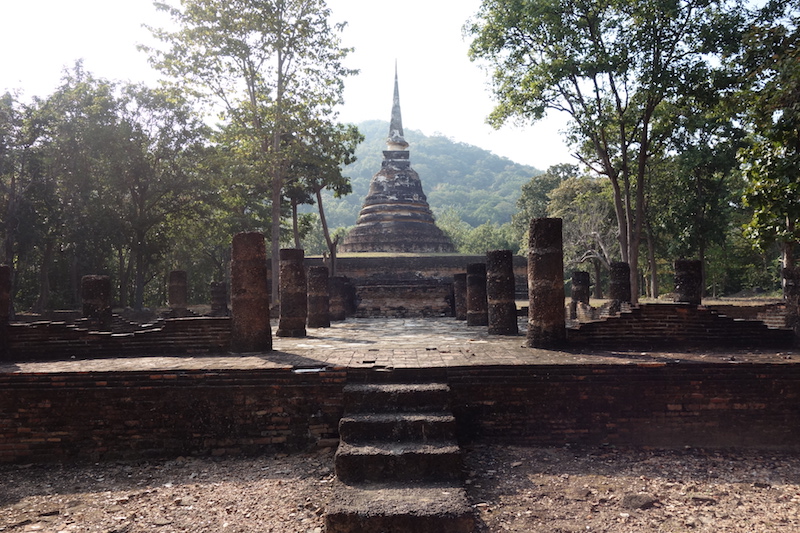 Stupa outside the city walls
Stupa outside the city walls
This from Wikipedia…
Traditional Thai historians considered the founding of the Sukhothai Kingdom as the beginning of the Thai nation because little was known about the kingdoms prior to Sukhothai. Modern historical studies demonstrate that Thai history began before Sukhothai. Yet the foundation of Sukhothai is still a celebrated event.
The old city is now called Sukhothai Historical Park, and in 1991 it was designated a UNESCO World Heritage site, and it is easy to see why. Sukhothai is roughly translated from Sanskrit as “dawn of happiness”. The grounds are fairly lush, well-maintained, easing one into a state of serenity. A serenity that betrays the blood that must have been spilled over the ups and downs of old regional wars, Thai, Burmese, Khmer and others. By the late 14th century the Sukhothai Kingdom was losing influence and was eventually subsumed by the Ayutthaya Kingdom that dominated the region for many centuries.
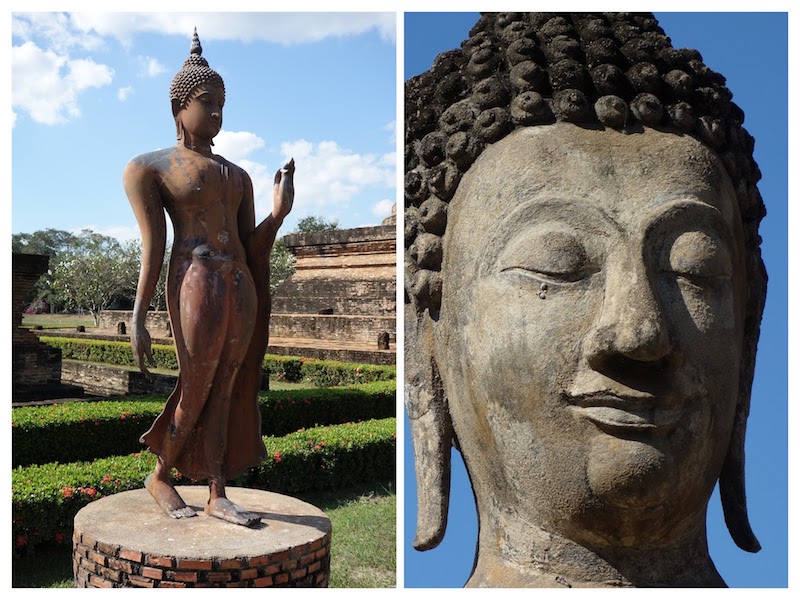 Statues. Left shows Sukhothai style of walking posture, imparting fearlessness
Statues. Left shows Sukhothai style of walking posture, imparting fearlessness
Much work has been done to restore ruins here and there, though really everything looks on the edge of collapse. The first day we explored on motorbike the sites outside the perimeter of the walls. The second day we rented bicycles and roamed around within the walls of the old city. It took a little while to find a bike with a real child seat for Asa – and that is only because most of the bikes we saw were secondhand from Japan. There are many tourists roaming around but, because it is quite large, we never felt like we were getting in the way of someone’s Instagram selfie.
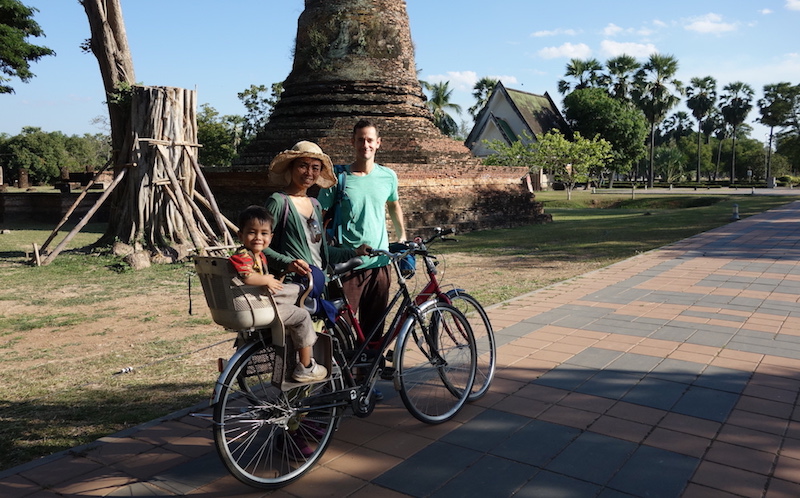 Bicycling in Old Sukhothai
Bicycling in Old Sukhothai
There was no obviously central or single most significant temple in the complex — though there were clearly some major sites. Notable highlights…
Wat Mahathat
The largest and most complicated temple site, with a labyrinth of remaining structures — columns, statues, stupas. The structures felt quite dense and somehow didn’t quite make sense, not following any overarching symmetry or discernible design. Like the whole complex, it must have been built incrementally over many decades.
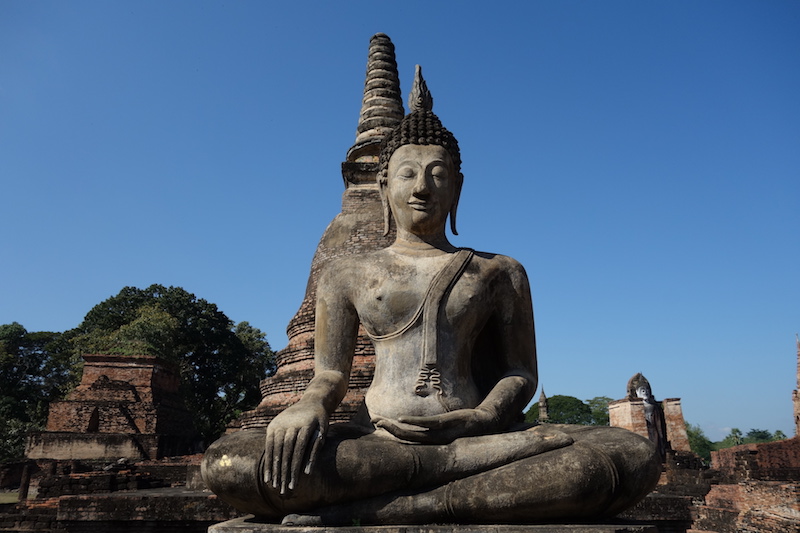 Wat Mahathat
Wat Mahathat
Wat Si Sawai
Possibly the oldest temple in the area, with a design that is clearly different from the others — it was originally built as a Hindu shrine to Vishnu, and later adapted / repurposed for the needs of the Buddhists leaders who took over.
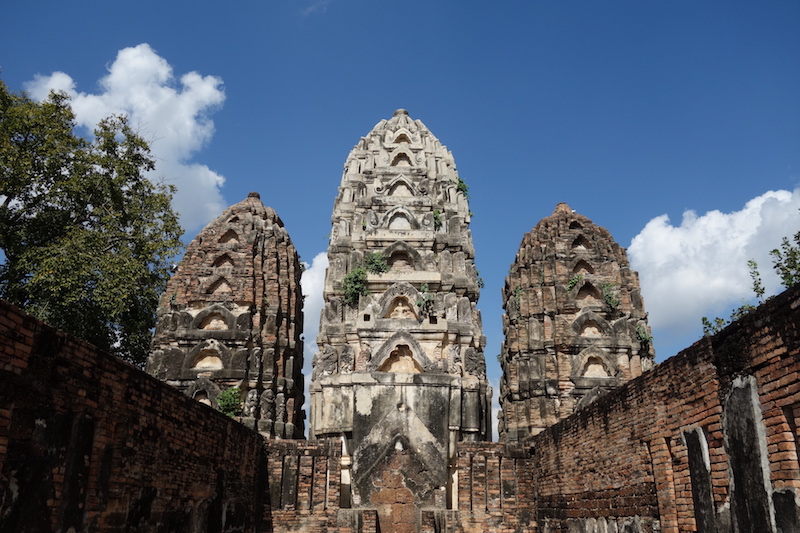 Wat Si Sawai
Wat Si Sawai
Wat Sa Si
Really the most picturesque temple as it’s enclosed in its own moat and connected with small bridges — one to the main grounds, and the other to a small island with a shrine. Unfortunately the moat was under renovation with construction vehicles tearing up the place.
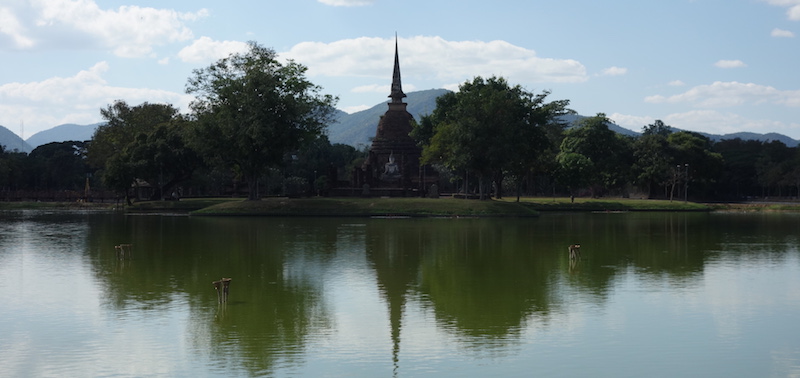
Saritphong Dam
Lies outside the city, and was constructed a large earthen dam as a reservoir to channel water into the canals and various moats of the city. The dam was restored at some point and gave a peaceful mirror image of the green mountains and little else – probably much the same 800 years ago.
 Saritphong Dam
Saritphong Dam
Phitsanulok
We didn’t really have time to explore any of New Sukhothai, a small city built down the road from the historical park. But after leaving our guesthouse in Sukhothai we spent one night in the neighboring city, Phitsanulok, which is probably pretty similar in size and feeling to New Sukhothai. The main activity we enjoyed was visiting the nearby temples, one of them had an herbal sauna — small steam rooms infused with the overpowering scent of lemongrass.
Our one night in Phitsanulok happened be Asa’s 4th birthday so he got to choose dinner: pizza, of course. There was a Pizza Hut just a short walk from our guesthouse. We came to Phitsanulok to be close to the airport because we had an early flight, and it didn’t help that we overslept and rushed through breakfast and minutes later onto a little tuk tuk. From Phitsanulok we caught a connecting flight in Bangkok and onto Luang Prabang, Laos.